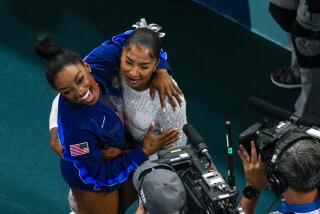Mothers Seen as Holding Key to Family Fitness
Out-of-shape American schoolchildren may have a new and, at first glance, somewhat unlikely group of fitness coaches: their mothers.
But, said a group of fitness experts and athletes gathered at UC Irvine last week for the first California Women’s Leadership Conference on Fitness and Health, the leading role of women in teaching good health habits to their families shouldn’t be underestimated.
“Women are a great influence on the health and the fitness attitudes of the family and they will be the ones who help get those attitudes on track,” said Harriet Harris, chairman of the conference. “You can’t start forming those attitudes too early. It begins in the cradle.”
The two-day conference was a statewide follow-up to the National Women’s Leadership Conference on Fitness, held in 1984 in Washington and sponsored by the President’s Council on Physical Fitness and Sports. California is the ninth state to hold such a follow-up meeting.
Nearly 400 conference attendees, most of them women dressed in exercise clothes, listened Thursday to talks by health professionals that focused in part on the role of women as fitness educators and role models for their families.
Better Examples Needed
At the conference’s opening ceremonies at the Irvine Hilton Wednesday night, the audience heard a recitation of statistics compiled from a survey by the President’s Council on Physical Fitness and Sports that showed, said speakers, the need for better examples of fitness in the home.
The nationwide survey, conducted last year with 18,857 public school children ages 6 to 17, found a continuing “low level of performance” in such key areas as running, jumping, flexibility and strength.
Among the survey’s findings:
- Forty percent of boys ages 6 to 12 and 70% of all the girls could not do more than one pullup.
- Half of the girls ages 6 to 17 and 30% of the boys ages 6 to 12 could not run a mile in less than 10 minutes.
- Forty-five percent of boys ages 6 to 14 and 55% of all the girls could not hold their chin over a raised bar for more than 10 seconds.
George Allen, former head coach of the Washington Redskins and Los Angeles Rams and currently chairman of the President’s Council on Physical Fitness and Sports, said he found the statistics “appalling.”
“When I hear that a 17-year-old can’t run a mile in less than 13 minutes, I think that’s a disgrace,” Allen said at the opening of the second day of the conference. “If I were grading the United States on fitness and comparing us with other nations, in my opinion we would be in last place in youth fitness. I think the fitness boom is a misconception because it isn’t there among the youth. It’s among adults and has nothing to do with kids.”
With Children More
Women, Allen said, should use their numbers and political influence in demanding a return of required physical education in schools. And, he added, in the home “women are better at communicating fitness to kids than men. They’re with kids more. They buy and prepare the food they eat. And they can set an example by being in shape themselves and by not smoking or drinking. They set an example by leading an active life.”
The conference itself was hardly inactive.
Those attending were encouraged in advance to wear exercise clothes in anticipation of a 20-minute “exercise break” led by Jacki Sorensen, the originator of aerobic dancing.
“The responsibility for the fitness of children doesn’t lie with the schools,” Sorensen said later. “It lies with the parents. Fitness for them should be as common as brushing your teeth, but so many adults are doing nothing.”
While fitness may have become fashionable with many adults, between 40% and 50% of adults still do not exercise regularly, Sorensen said. And, as a result, neither do their children.
Life-Style Point of View
“You can’t fool kids,” she said. “And you can’t just do it by example. You have to involve your kids in it. I think it’s really wrong to teach a young child to exercise because they already do it through play. They have natural exuberance. When they get older, though, you have to approach fitness through a life-style point of view and not an actual exercise program.”
Often, Sorensen said, regimented exercise programs are so difficult that many beginners give up at the start.
“We have to come up with programs that are easier,” she said. “Right now, in the health clubs, what you have are the semi-elite of fitness. The classes at the clubs are a bit too difficult around the country. It (exercise) needs to be introduced gently, gradually. You shouldn’t start with the optimum. It doesn’t even have to be aerobic. Maybe just walking and talking. What better time to talk to your kids? Ask them what they want to do. If they want to go on a picnic, park a mile away and walk to the place you’re going to have the picnic.”
Pat McCormick, the four-time Olympic gold medal-winning diver who spoke at the close of the session Thursday, said her own children found fitness to be a natural part of family life. So much so, in fact, that her daughter Kelly won a silver medal in the three-meter diving event at the 1984 Olympic Games. It was the first time in Olympic history that a mother and daughter had won Olympic medals.
‘Did It Together’
“My kids never knew what it was like to learn to swim (in a regimented swimming class),” McCormick said. “We just all did it together. I always tried to create an atmosphere (of fitness) for them, to try to expose them to everything, every sport. I think if you give them the groundwork and enough variety, they’ll pick the sport they like and go with it. You put them in a position where they can win.
“I’ve always stressed lifetime sports, activities you can do all your life. And it should always be fun.”
Bob Mathias, a two-time Olympic gold medal winner in the decathlon who is regarded as one of the greatest athletes in Olympic history, said he remains active in what he, too, called “lifetime sports”--tennis, skiing and racquetball.
“No matter what you do in life,” said Mathias, the executive director of the National Fitness Foundation, “it’s the early training you get that determines what you’ll do throughout life. In high school, a lot of kids don’t think too much about what kind of shape they’re in, but once they get out of college they start to realize they have to do something about their bodies.”
Cutbacks in many school physical education programs has hurt the cause of fitness, he said.
An Early Education
“I think PE is just as important as English,” Mathias said. “The public schools keep knocking it out, but it’s one of the ways to get kids programmed early about fitness. That’s why it’s important for women to learn about fitness and be aware of it so they can teach their kids about it.”
Tennis star Tracy Austin, a special adviser to the President’s Council on Physical Fitness and Sports, said fitness awareness in her family revolved around tennis.
“I’ve been lucky in my family,” she said, “because we all play. And we’ve always kept it fun. That’s really important--it has to be fun. And it should be convenient, something you can do on your own time. It doesn’t matter if you’re good at it. If you don’t enjoy aerobics, for instance, then don’t do aerobics. Women can help keep lots of possibilities open to their families.”
And it is often the mother, said Austin, who is the determiner not only of a family’s fitness activities, but of the forming of good health habits.
“Women often are the ones who do the shopping and provide the nutrition,” Austin said. “It’s up to them whether they buy Sugar Pops or not. They can set an example for so much. If the child wants to be great (at a sport) or just good, it’s up to them. The difference is their desire. But the woman can be a role model.”
More to Read
Sign up for Essential California
The most important California stories and recommendations in your inbox every morning.
You may occasionally receive promotional content from the Los Angeles Times.










